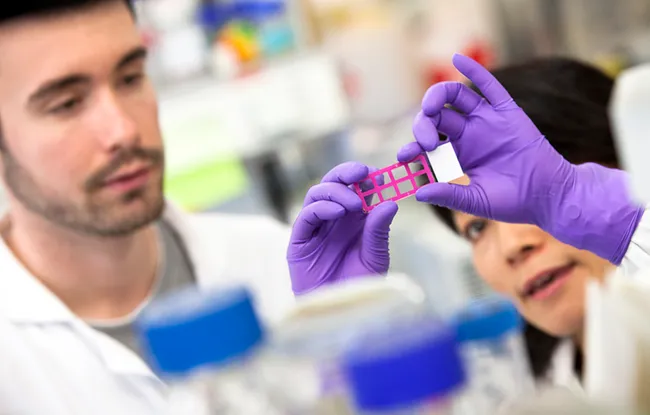- Home >
- Institut Curie News >
- FHL3: A Scaffold Protein, Architect of the Embryonic Nervous System
At the earliest stage of its development, the vertebrate embryo is made up of three cell layers: the ectoderm, mesoderm, and endoderm. When it is preparing its future central nervous system, part of the ectoderm thickens into a "neural plate" which folds back on itself to form the neural tube on one side and the epidermis on the other.
At the top of the fold lays the neural crest, a group of cells that will break away from the neural tube and migrate, transforming themselves into a range of cells or tissues such as the peripheral nervous system, melanocytes, craniofacial structures, etc. To build this neural crest, several coordinated signals involving proteins belonging to the BMP (proteins initially isolated in the developing bone) and WNT (initially isolated in the embryo of Drosophila) families are sent to the ectoderm and the mesoderm.
In order that a small ball of cells transforms into an embryo, these signals, either weak or strong, will be expressed in multiple combinations. But how do cells and tissue interpret these signals, played at varying strengths from piano to forte? Why do cells that receive the same signals at the same strength differ from each other? Researchers from the Signaling and Neural Crest Development team directed by Anne-Hélène Monsoro-Burq* have managed to decrypt some of these still-mysterious mechanisms.
A Strict Regulation of Signals in Time and Space
In an amphibian model, they showed how the mesoderm and ectoderm, when subjected to the same level of BMP signaling, interpreted information differently through FHL3 protein intervention.
It’s a scaffold protein that favors molecular partnerships in the cell and activates them, probably by facilitating their migration to the cell nucleus and the target gene
explains Anne-Hélène Monsoro-Burq, head of the research team and co-author of the publication.
FHL3 thus functions as an intracellular modulator that amplifies the response to BMP signaling. In the mesoderm, this activates WNT signaling. Because the outer ectoderm does not contain FHL3, it has a weak response to BMP signals, which allows it to become neural tissue. Influenced by WNT, FHL3 then is activated in the ectoderm, eliciting a strong and simultaneous response to BMP and WNT, which then induces neural crest formation
In just a few hours, FHL3’s fine-tuned spatio-temporal modulation controls the progressive refinement of embryonic tissues.
This research uncovers valuable new knowledge not only about embryonic development but also about the mechanisms of cancer. Indeed, FHL3 is a new “player” that needs to be accounted for in studies on the roles of signaling pathway dysfunction and embryonic mechanism reactivation in cell proliferation, tumor progression, or metastasis formation.
* CNRS UMR3347 / Inserm U1021 / Institut Curie / Université Paris-Saclay
This work was supported by Agence Nationale pour la Recherche (ANR-15-CE13-0012-01-CRESTNETMETABO), Fondation pour la Recherche Médicale (DEQ20150331733), and Institut Universitaire de France.
|
Citation: Alkobtawi M, Pla P, Monsoro-Burq AH. BMP signaling is enhanced intracellularly by FHL3 controlling WNT-dependent spatiotemporal emergence of the neural crest. | Cell Rep. 2021 Jun 22; 35(12): 109289. doi: 10.1016/j.celrep.2021.109289. |
Research News
Discover all our news
Celebration
The Immunity and Cancer research unit (U932) celebrates its twentieth anniversary
12/12/2025
Artificial Intelligence
08/12/2025



